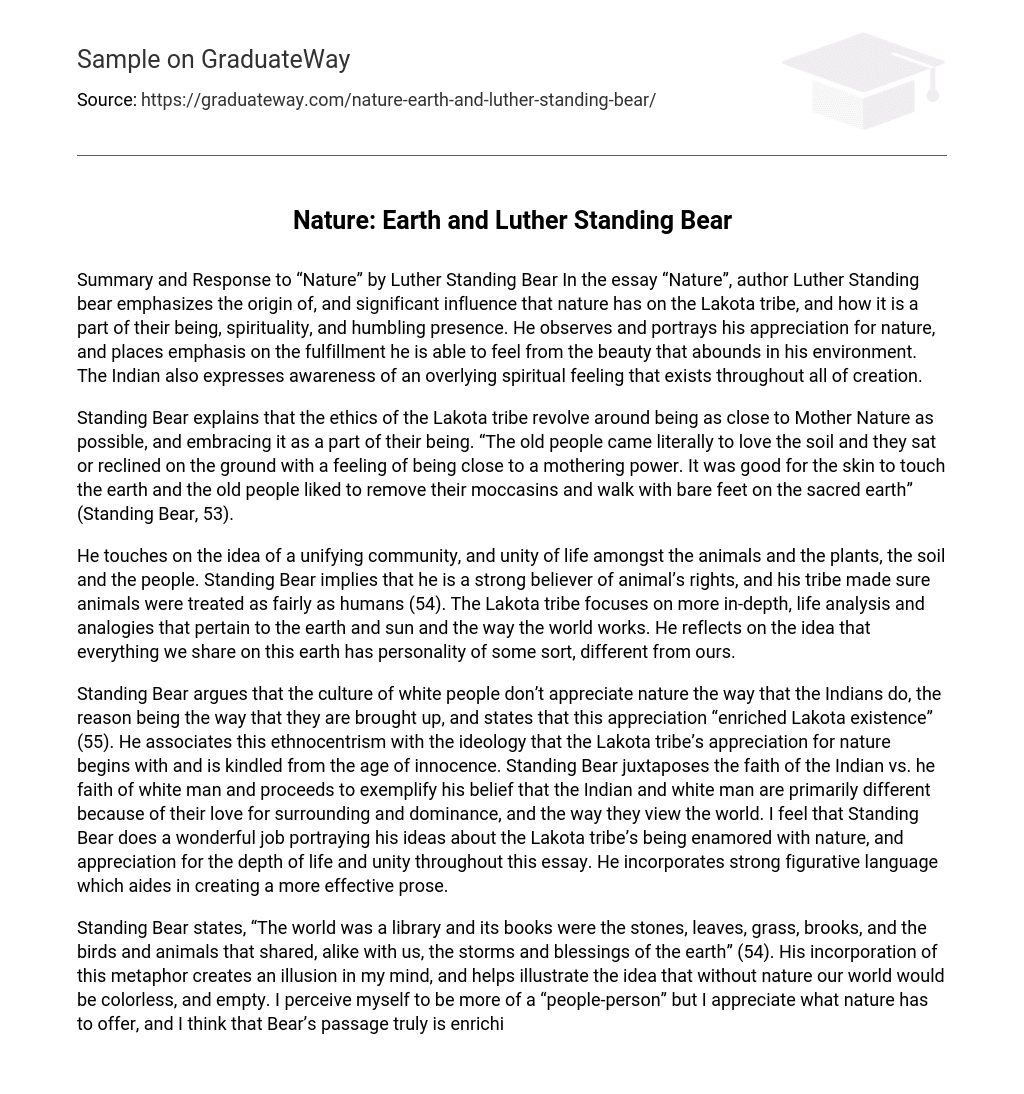Summary and Response to “Nature” by Luther Standing Bear In the essay “Nature”, author Luther Standing bear emphasizes the origin of, and significant influence that nature has on the Lakota tribe, and how it is a part of their being, spirituality, and humbling presence. He observes and portrays his appreciation for nature, and places emphasis on the fulfillment he is able to feel from the beauty that abounds in his environment. The Indian also expresses awareness of an overlying spiritual feeling that exists throughout all of creation.
Standing Bear explains that the ethics of the Lakota tribe revolve around being as close to Mother Nature as possible, and embracing it as a part of their being. “The old people came literally to love the soil and they sat or reclined on the ground with a feeling of being close to a mothering power. It was good for the skin to touch the earth and the old people liked to remove their moccasins and walk with bare feet on the sacred earth” (Standing Bear, 53).
He touches on the idea of a unifying community, and unity of life amongst the animals and the plants, the soil and the people. Standing Bear implies that he is a strong believer of animal’s rights, and his tribe made sure animals were treated as fairly as humans (54). The Lakota tribe focuses on more in-depth, life analysis and analogies that pertain to the earth and sun and the way the world works. He reflects on the idea that everything we share on this earth has personality of some sort, different from ours.
Standing Bear argues that the culture of white people don’t appreciate nature the way that the Indians do, the reason being the way that they are brought up, and states that this appreciation “enriched Lakota existence” (55). He associates this ethnocentrism with the ideology that the Lakota tribe’s appreciation for nature begins with and is kindled from the age of innocence. Standing Bear juxtaposes the faith of the Indian vs. he faith of white man and proceeds to exemplify his belief that the Indian and white man are primarily different because of their love for surrounding and dominance, and the way they view the world. I feel that Standing Bear does a wonderful job portraying his ideas about the Lakota tribe’s being enamored with nature, and appreciation for the depth of life and unity throughout this essay. He incorporates strong figurative language which aides in creating a more effective prose.
Standing Bear states, “The world was a library and its books were the stones, leaves, grass, brooks, and the birds and animals that shared, alike with us, the storms and blessings of the earth” (54). His incorporation of this metaphor creates an illusion in my mind, and helps illustrate the idea that without nature our world would be colorless, and empty. I perceive myself to be more of a “people-person” but I appreciate what nature has to offer, and I think that Bear’s passage truly is enriching; he was able to bring out the nature loving part of me through his poetic-like style.
He was able to create a euphoric rhythm through his passionate tone and vivid imagery which really drew me into the reading; “The morning and evening star always attracted attention, and the Milky Way was a path which was traveled by the ghosts” (54). His voice illuminates his writing and evoked in me a sensation of ardor for my surroundings. Because of this, I’m also eager to delve even more into the “reflection upon life and its meaning”; I was already enthusiastic about this subject before stumbling upon Bear’s essay about Nature and life, but I was able to see things from another perspective, another culture, which further intrigued me.
One thing I found questionable was that a young age, as a member of the Lakota tribe, one was taught to love nature, to enrich their life with your surroundings, and in a sense fill their being with love and humbleness. Standing Bear criticizes the behavior of white boys and states, “In contrast, Indian boys, who are naturally reared, are alert to their surroundings; their senses are not narrowed to observing only one another, and they cannot spend hours seeing nothing, hearing nothing, and thinking nothing in particular” (55).
What I find a bit controversial is the fact that these kids were only raised in a matter to love nature and make it a part of their being, and I feel that this just results a scarcity of individualism. Much like religion, if we are only taught to believe one way, or that one thing is correct, how are we supposed to know that without these beliefs, we wouldn’t be Catholic not Muslim? Or Buddhist not Christian? Of course the Lakota tribe is its own culture, but I’m a bit skeptical about the idea of conformity.
Why is it that all Lakota tribe members are stereotyped to be nature-loving and peaceful? They may value and incorporate nature more into their life, but Standing Bear talks about the “character of an Indian’s emotion” (55), and how it leaves little room for antagonism toward his fellow creatures and gives them what is referred to be “the Indian point of view”, and I think that humans, whether it may be white man or Indian, will all learn the concept of conflict, antagonism, and we all create a bit of our own learned culture.
I am a reflective writer, and I appreciated Bear’s analytical style?I had never considered the relationship between life and nature until I came across Bear’s work. He did a wonderful job using ethos to establish author-reader credibility by having maintaining strong sense of voice? I really did enjoy the essay Nature by Luther Standing bear, and I would love to read more work by this author. Standing Bear, Luther. “Nature. ” Saving Place: An Ecocomposition Reader. Ed.





